Emperor Butterfly Animal Crossing Price
Animal Crossing Bugs list: All bug prices, locations, and how to catch rare bugs explained
All bugs you can grab in Brute Crossing - and where to find them.
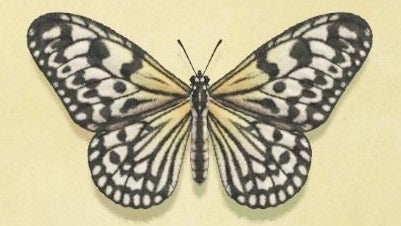
Bug catching is a crucial activeness in Animal Crossing: New Horizons. Not only does information technology aid y'all complete the Museum, but information technology's also a peachy way to earn some bells if you manage to catch some rare bugs.
Yous tin can also unlock the DIY recipe for the Gold Net by catching every issues in New Horizons. Quite the task, but a worth reward!
Similar fish and other aspects of the game, many of the bugs that appear on your isle are seasonal, which means that dissimilar bugs will appear on your island depending on what calendar month it is.
This Animate being Crossing problems list focuses on the Northern Hemisphere for the times of the year insects come and go, but if yous want a condensed wait at the weeks ahead, we have a dedicated new fish and insects arriving and leaving this month folio.
On this page:
- How to increase your chances of catching bugs in Beast Crossing: New Horizons
- How to take hold of rare bugs and the best bug prices in Fauna Crossing: New Horizons explained
- Animate being Crossing: New Horizons Bugs and their prices list
How to increase your chances of catching bugs in Animal Crossing: New Horizons
Like with angling, the nuts of communicable bugs in New Horizons is pretty simple.
Start you need to craft a Net, and so head out exploring on your island. It won't be long earlier y'all find a bug and, once yous take, y'all're left with two choices.
The beginning is to simply walk up to the bug and swing your net in an endeavour to grab it. This is a good approach for bugs that motion quite quickly, like butterflies, or ones that are less likely to run abroad, like bagworms. Withal, information technology does run the risk of altering the bug to your presence and making information technology fly away.
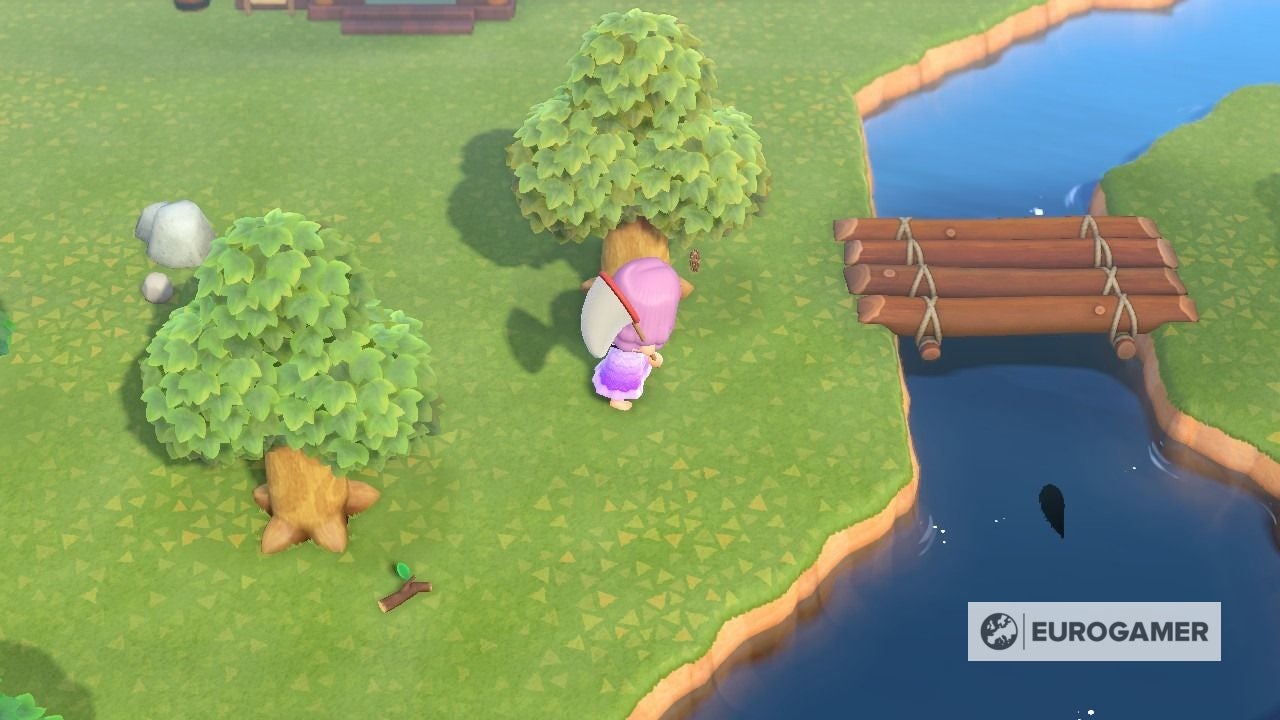
If you desire to ensure that your prey doesn't flee, you demand to accept the second, far sneakier, approach to problems hunting.
When you spot the issues you wish to catch hold down the A button. This will let you to slowly pitter-patter y'all to the bug and capture it, before information technology manages to escape.
Sneaking up on bugs might take a bit of do, because sure bugs, like Tarantulas, have the power to spot you and preclude you lot from communicable them.

One time you lot've mastered the basics of bug catching, it'southward time to take hold of your net and beginning filling in the entries in your Critterpedia. Below you'll notice some more tips to help you catch them all:
- If yous're out bug hunting then it's a good idea to walk, not run. It'due south easier for bugs to find you if you're running, which will let them to escape.
- A lot of bugs, especially collywobbles, are attracted to Flowers. For this reason, information technology's a good idea to set up a couple of flower gardens beyond your island. This style you can quickly visit and see if there are any rare bugs for you lot to catch. Likewise, the rarer the colour, the more likely rare insects will announced there.
- Like with fish, certain bugs are weather dependent. Snails, for example, will but appear on rocks when information technology's raining.
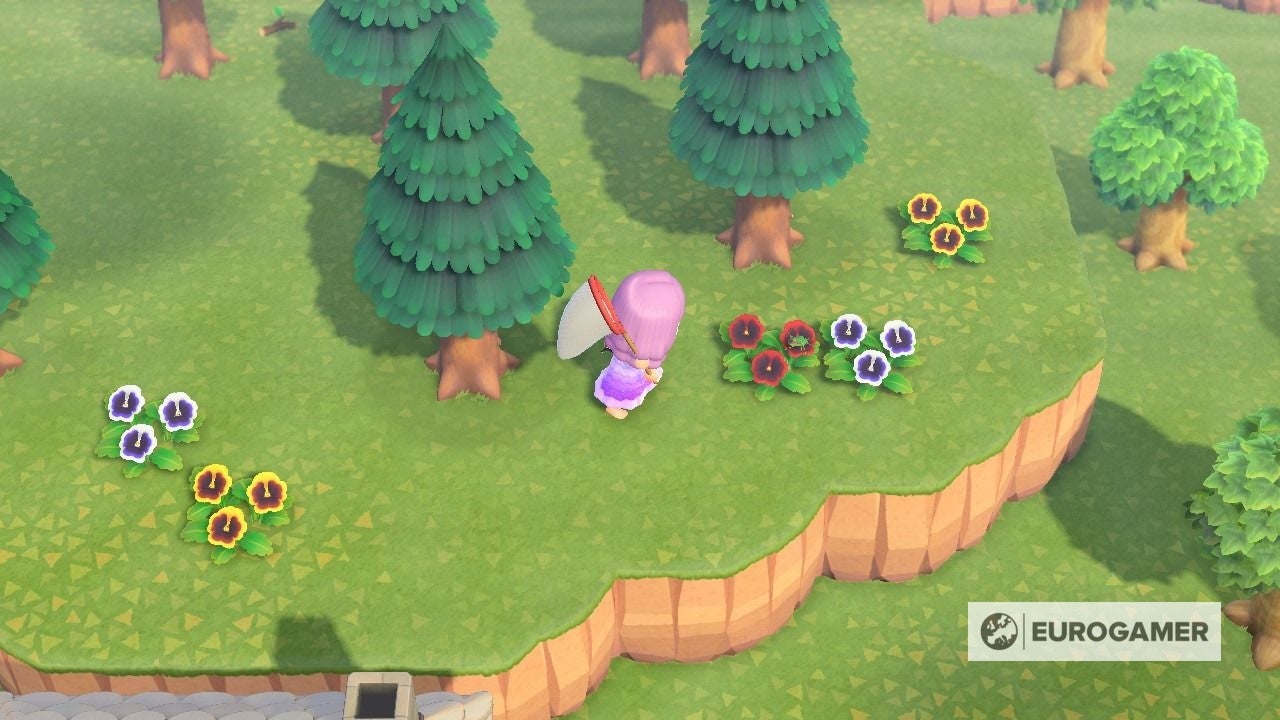
- Unlike fish, bugs can appear anywhere beyond your island. This ways your Vaulting Pole and Ladder are essential tools on any good issues hunt. You don't desire to lose out on catching a rare butterfly, especially when it flies up a cliff or across a river.
- Go along not simply your eyes peeled but your ears abrupt, as you lot never know what activeness might reveal a new bug. You lot might exist harvesting Fe Nuggets from a rock or just walking around when you see or hear the sign of a new bug.
- Certain bugs require special items or actions to exist completed to allow you to either catch them or take them appear. Wasps, for instance, will merely appear if a wasp nest falls from a tree when you're shaking or chopping, while flies can just appear if yous go out a slice of trash on the basis. Our bug listing at the cease of this page explains their various sources, but if you don't want them spoilt for you, information technology's worth experimenting with things which might concenter them in real life. Bugs tin can appear in all sorts of means!
The Animal Crossing two.0 update and Happy Home Paradise is here! Nosotros can help yous with the new additions - including where to find Brewster, Gyroids, new villagers, ordinances, new fences, storage shed, new hairstyles, Froggy Chair, group stretching and Kapp'northward gunkhole tours. Cooking is now unlockable, so y'all need to know how to make both flour and sugar, as well as how to grow carrots, potatoes and tomatoes. Meanwhile, if yous're new to Animal Crossing, our New Horizons tips can aid with the basics. From the off, there'south fish and bugs to take hold of, flowers and fruit to grow with. One long term goal is edifice your Happy Abode University score. Finally, you need tools such as the new ladder and vaulting pole to fully explore.
How to catch rare bugs and the best bug prices in Animal Crossing: New Horizons explained
Communicable rare bugs in New Horizons is a great style to earn some bells, especially if you're shut to paying off ane of your many mortgages.
Yet, as the word rare implies, these bugs tin can be very difficult to catch; you need to be light of foot and swift of hand to catch many of these. You'll also want lady luck to be on your side, because, due to their rarity, these bugs have a depression appearance rate.
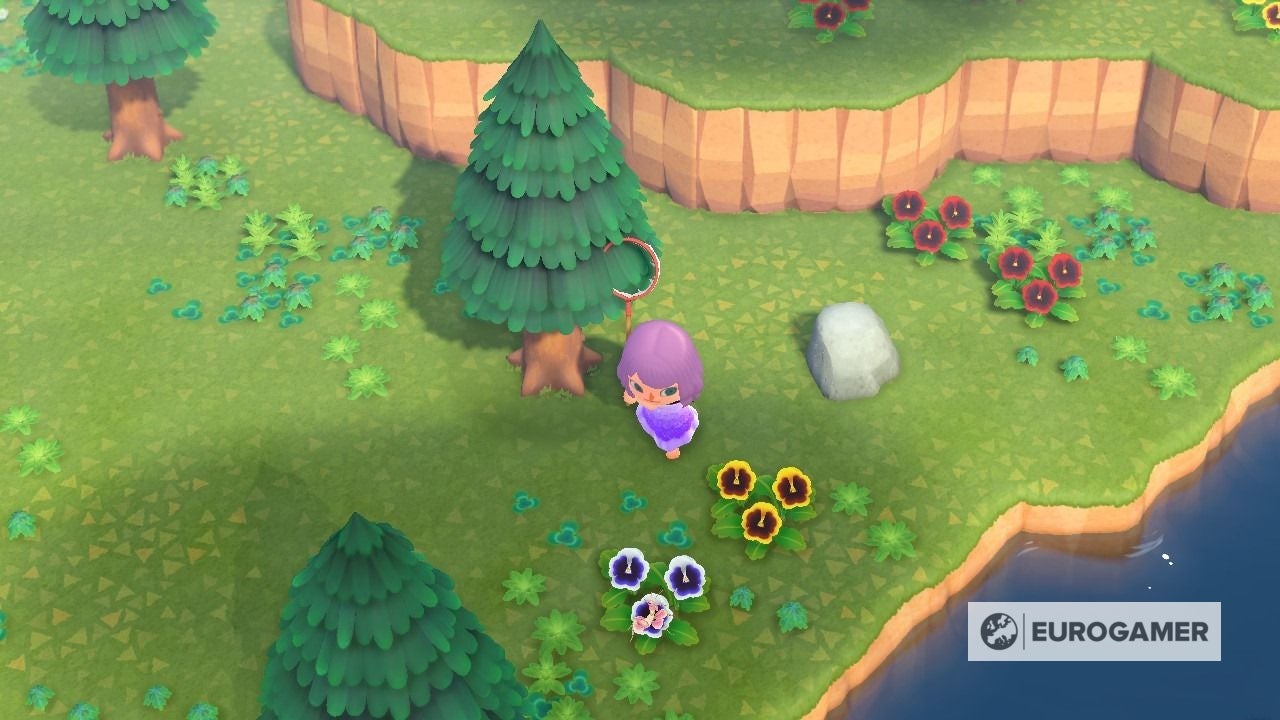
Y'all can, nonetheless, create your own luck past scaring away the bugs y'all don't want to grab. Every island can only hold a sure number of bugs at one time; communicable or scaring away bugs will cause new ones to spawn, some of which might be the bugs y'all're looking for.
Information technology should exist noted that there are more lucrative coin making methods in New Horizons, such equally selling selling Turnips.
Nevertheless, it's e'er a good idea to take hold of a rare problems when y'all see it - those extra bells won't injure.
Below you'll observe our recommendations for which bugs y'all should focus on communicable in New Horizons:
Orchid Mantis (bug price - 2,400 bells) - Orchid Mantis will appear on flowers between the months of March to November from 8am to 5pm. Thanks to their pinkish colouring, they should stand out hands from the flowers. Still, always make sure you sneak up on them or else they'll make a quick escape.

Peacock Butterfly (bug price - ii,500 bells) - Peacock Butterflies will visit your isle from March to the end of June and will announced betwixt the hours of 4am to 7pm. If you lot're having trouble finding these butterflies, enquire a friend to send you some seeds from their isle, because, the rarer the flower, the more probable these butterflies will appear.
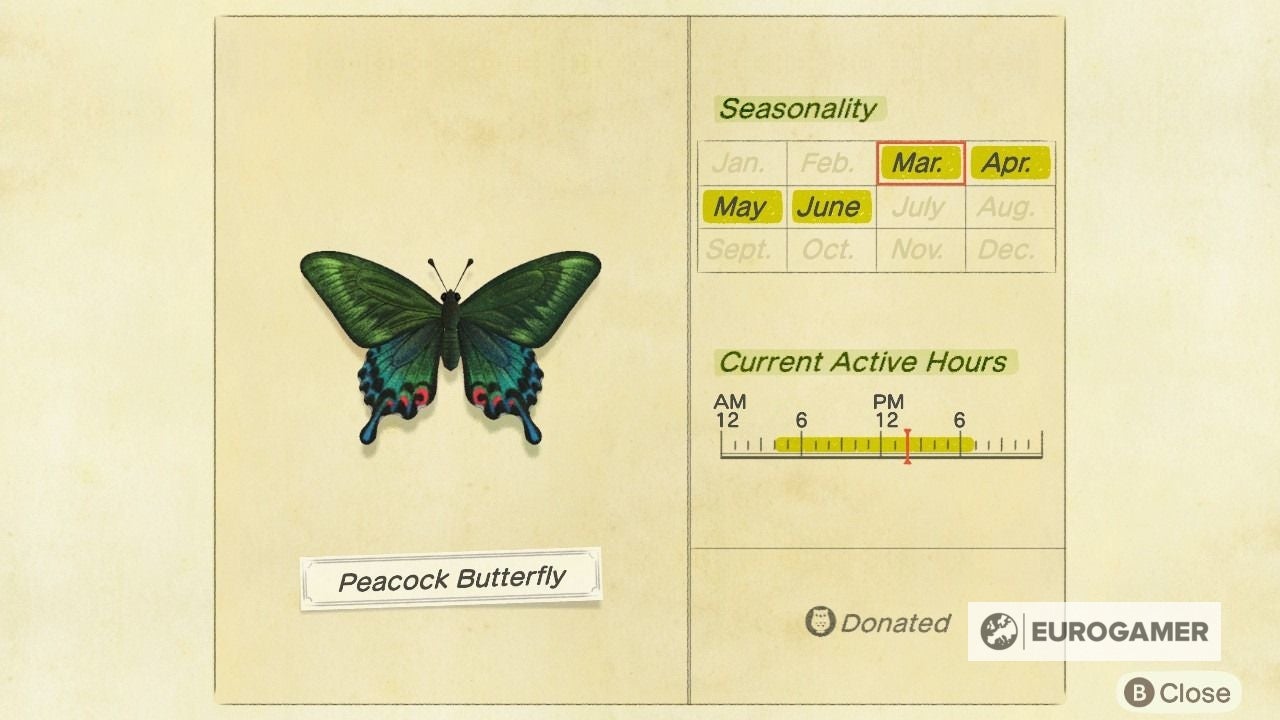
Wasp (bug cost - 2,500 bells) - no matter the calendar month, no matter the time, there's always a gamble that you'll find a wasps nest in New Horizons. All you lot have to do is proceed shaking those trees and eventually 1 will fall, bringing the wrath of the wasp down upon you lot. Communicable a wasp is the hard part - it relies on quick reactions and not accidentally running into any trees.
If you demand more than help regarding wasps, cheque out our dedicated wasp page.

Tarantula (bug price - viii,000 bells) - Tarantulas can appear anywhere on your island from the beginning of November till the stop of Apr between 7pm to 4am. If you lot've already heard of the fabled Tarantula Isle, then you already know that catching these spiders is ane of the all-time ways to make a lot of money very rapidly. Just brand sure you pay close attention to the tarantula you're trying to grab.
If you're having problem communicable tarantulas, check out our dedicated tarantula folio.
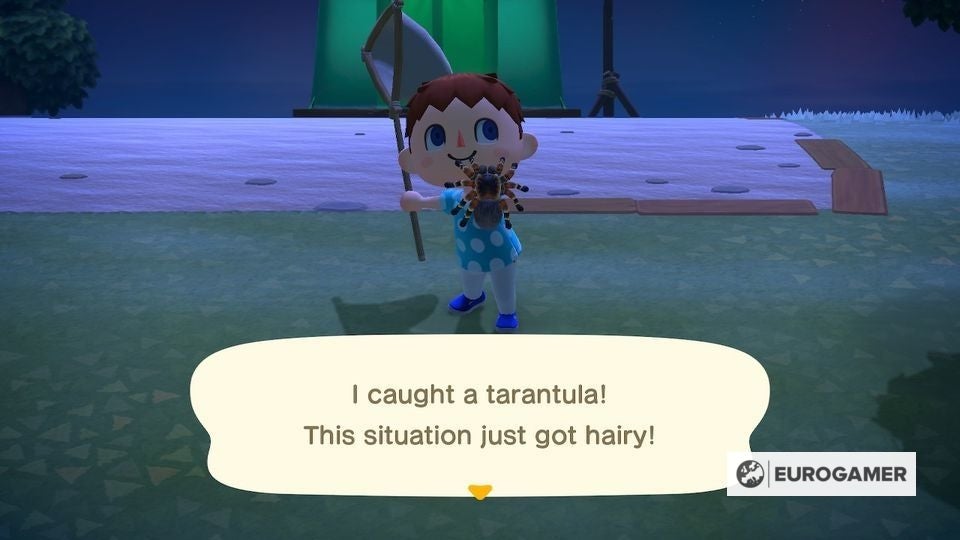
Fauna Crossing: New Horizons Bugs and their prices list
Here is a listing of all the bugs in Animate being Crossing: New Horizons, too equally their spawning conditions and other behaviours to exist aware of.
Call up, bugs will come in and out of rotation throughout the yr, then it's impossible to get everything at any given time. If you lot're hoping to get them all and want to see what's urgent - the things about to leave, and what's appearing - our dedicated new fish and insects arriving this month page can help yous run across these at a glance.
It should be noted that the following months are for the northern hemisphere. If your island is in the southern hemisphere, and so each prepare of dates volition differ by half dozen months.
Hither are all bugs in Animate being Crossing: New Horizons, in the order they appear in the Critterpedia:
| Animal Crossing Bugs | Months available | Times bachelor | Location | Bug Price |
|---|---|---|---|---|
| Common Butterfly | September to June (Northern hemisphere) March to Dec (Southern hemisphere) | 4am to 7pm | Flying effectually | 160 |
| Xanthous Butterfly | March to June / September to October (Northern hemisphere) March to April / September to December (Southern hemisphere) | 4am to 7pm | Flying around | 160 |
| Tiger Butterfly | March to September (Northern hemisphere) September to March (Southern hemisphere) | 4am to 7pm | Flying around | 240 |
| Peacock Butterfly | March to June (Northern hemisphere) September to December (Southern hemisphere) | 4am to 7pm | Flight around flowers | 2500 |
| Common Bluebottle | April to Baronial (Northern hemisphere) October to February (Southern hemisphere) | 8am to 4pm | Flying effectually | 300 |
| Paper Kite Butterfly | All year round | 8am to 7pm | Flight around | thou |
| Great Royal Emperor | May to August (Northern hemisphere) Nov to February (Southern hemisphere) | 4am to 7pm | Flight around | 3000 |
| Monarch Butterfly | September to November (Northern hemisphere) March to May (Southern hemisphere) | 4am to 5pm | Flying around | 140 |
| Emperor Butterfly | December to March / June to September (Northern hemisphere) December to March / June to September (Southern hemisphere) | 5pm to 8am | Flying around flowers | 4000 |
| Agrias Butterfly | April to September (Northern hemisphere) November to March (Southern hemisphere) | 8am to 5pm | Flight around | 3000 |
| Rajah Brooke'due south Birdwing | Apr to September / December to February (Northern hemisphere) Nov to March / June to August (Southern hemisphere) | 8am to 5pm | Flying around | 2500 |
| Queen Alexandra's Birdwing | May to September (Northern hemisphere) November to March (Southern hemisphere) | 8am to 4pm | Flying around | 4000 |
| Moth | All twelvemonth round | 7pm to 4am | Flying effectually a lightsource | 130 |
| Atlas Moth | Apr to September (Northern hemisphere) October to March (Southern hemisphere) | 7pm to 4am | On trees | 3000 |
| Madagascan-Sunset Moth | April to September (Northern hemisphere) October to March (Southern hemisphere) | 8am to 4pm | Flying effectually flowers | 2500 |
| Long Locust | April to November (Northern hemisphere) November to May (Southern hemisphere) | 8am to 7pm | On the ground | 200 |
| Migratory Locust | August to Nov (Northern hemisphere) / Feb to May (Southern hemisphere) | 8am to 7pm | On the ground | 600 |
| Rice Grasshopper | Baronial to November (Northern hemisphere) / February to May (Southern hemisphere) | 8am to 7pm | On the ground | 400 |
| Grasshopper | July to September (Northern hemisphere) January to March (Southern hemisphere) | 8am to 5pm | On the ground | 160 |
| Cricket | September to Nov (Northern hemisphere) March to May (Southern hemisphere) | 5pm to 8am | On the ground | 130 |
| Bong Cricket | September to Oct (Northern hemisphere) March to Apr (Southern hemisphere) | 5pm to 8am | On the ground | 430 |
| Mantis | March to November (Northern hemisphere) September to May (Southern hemisphere) | 8am to 5pm | On flowers | 430 |
| Orchid Mantis | March to November (Northern hemisphere) September to May (Southern hemisphere) | 8am to 5pm | On flowers | 2400 |
| Honeybee | March to July (Northern hemisphere) September to January (Southern hemisphere) | 8am to 5pm | Flight around flowers | 200 |
| Wasp | All year round | All mean solar day | Shake trees till a wasp nest falls, then grab them earlier they sting you | 2500 |
| Brown Cicada | July to August (Northern hemisphere) January to February (Southern hemisphere) | 8am to 5pm | On trees | 250 |
| Robust Cicada | July to August (Northern hemisphere) January to Feb (Southern hemisphere) | 8am to 5pm | On trees | 300 |
| Giant Cicada | July to Baronial (Northern hemisphere) Jan to February (Southern hemisphere) | 8am to 5pm | On trees | 500 |
| Walker Cicada | August to September (Northern hemisphere) February to March (Southern hemisphere) | 8am to 5pm | On trees | 400 |
| Evening Cicada | July to August (Northern hemisphere) January to Feb (Southern hemisphere) | 4am to 8am 4pm to 7pm | On trees | 550 |
| Cicada Shell | July to August (Northern hemisphere) January to February (Southern hemisphere) | All solar day | On trees | 10 |
| Cerise Dragonfly | September to October (Northern hemisphere) March to April (Southern hemisphere) | 8am to 7pm | Flying effectually | 180 |
| Darner Dragonfly | Apr to October (Northern hemisphere) March to Apr (Southern hemisphere) | 8am to 5pm | Flying around | 230 |
| Banded Dragonfly | May to Oct (Northern hemisphere) November to April (Southern hemisphere) | 8am to 5pm | Flying effectually | 4500 |
| Damselfly | November to Feb (Northern hemisphere) May to August (Southern hemisphere) | All solar day | Flying around | 500 |
| Firefly | June (Northern hemisphere) December (Southern hemisphere) | 7pm to 4am | Flying around | 300 |
| Mole Cricket | November to May (Northern hemisphere) November to March (Southern hemisphere) | All day | Heed for its buzzing noise, then dig holes until one appears | 500 |
| Pondskater | May to September (Northern hemisphere) November to March (Southern hemisphere) | 8am to 7pm | On ponds and rivers | 130 |
| Diving Bettle | May to September (Northern hemisphere) Nov to March (Southern hemisphere) | 8am to 7pm | On ponds and rivers | 800 |
| Giant Water Problems | April to September (Northern hemisphere) October to March (Southern hemisphere) | 7pm to 8am | On a pond | 2000 |
| Stinkbug | March to October (Northern hemisphere) September to Apr (Southern hemisphere) | All twenty-four hours | On flowers | 120 |
| Man-faced Stink Bug | March to Oct (Northern hemisphere) September to April (Southern hemisphere) | 7pm to 8am | On flowers | 1000 |
| Ladybug | March to June / October (Northern hemisphere) September to Dec / Apr (Southern hemisphere) | 8am to 5pm | On flowers | 200 |
| Tiger Bettle | February to Oct (Northern hemisphere) August to April (Southern hemisphere) | All day | On the ground | 1500 |
| Gem Protrude | April to August (Northern hemisphere) Oct to Feb (Southern hemisphere) | All day | Appears on tree stumps | 2400 |
| Violin Beetle | May to June / September to November (Northern hemisphere) March to May / November to December (Southern hemisphere) | All day | Appears on tree stumps | 450 |
| Citrus Long-horned Protrude | All twelvemonth round | All day | Appears on a tree stump | 350 |
| Rosalia Batesi Beetle | May to September (Northern hemisphere) November to March (Southern hemisphere) | All day | Appears on a tree stump | 3000 |
| Bluish Weevil Protrude | July to Baronial (Northern hemisphere) January to February (Southern hemisphere) | All twenty-four hour period | Appears on a tree stump | 800 |
| Dung Protrude | Dec to February (Northern hemisphere) June to August (Southern hemisphere) | All day | On the ground rolling snowballs | 3000 |
| Earth-tiresome Dung Beetle | July to September (Northern hemisphere) January to February (Southern hemisphere) | All day | On the ground | 300 |
| Scarab Beetle | July to August (Northern hemisphere) January to February (Southern hemisphere) | 11pm to 8am | On trees | 10000 |
| Drone Beetle | June to Baronial (Northern hemisphere) December to February (Southern hemisphere) | All solar day | On copse | 200 |
| Goliath Beetle | June to September (Northern hemisphere) December to March (Southern hemisphere) | 5pm to 8am | On copse | 8000 |
| Saw Stag | July to August (Northern hemisphere) Jan to Feb (Southern hemisphere) | All 24-hour interval | On trees | 2000 |
| Miyama Stag | July to August (Northern hemisphere) January to February (Southern hemisphere) | All day | On trees | 1000 |
| Behemothic Stag | July to August (Northern hemisphere) Jan to February (Southern hemisphere) | 11pm to 8am | On copse | 10000 |
| Rainbow Stag | June to September (Northern hemisphere) December to March (Southern hemisphere) | 7pm to 8am | On copse | 6000 |
| Cyclommatus Stag | July to August (Northern hemisphere) January to Feb (Southern hemisphere) | 5pm to 8am | On coconut trees | 8000 |
| Golden Stag | July to August (Northern hemisphere) January to February (Southern hemisphere) | 5pm to 8am | On kokosnoot trees | 12000 |
| Giraffe Stag | July to August (Northern hemisphere) January to Feb (Southern hemisphere) | 5pm to 8am | On copse | 12000 |
| Horned Dynastid | July to August (Northern hemisphere) January to February (Southern hemisphere) | 5pm to 8am | On trees | 1350 |
| Horned Atlas | July to August (Northern hemisphere) January to Feb (Southern hemisphere) | 5pm to 8am | On kokosnoot copse | 8000 |
| Horned Elephant | July to August (Northern hemisphere) January to Feb (Southern hemisphere) | 5pm to 8am | On coconut trees | 8000 |
| Horned Hercules | July to August (Northern hemisphere) January to February (Southern hemisphere) | 5pm to 8am | On coconut trees | 12000 |
| Walking Stick | July to Nov (Northern hemisphere) Jan to May (Southern hemisphere) | 4am to 8am 5pm to 7pm | On trees | 600 |
| Walking Leafage | July to September (Northern hemisphere) Jan to March (Southern hemisphere) | All twenty-four hours | Under trees disguised as leaves | 600 |
| Bagworm | All year round | All day | Shake copse until 1 hangs downward | 600 |
| Pismire | All yr round | All day | Volition appear on spoiled turnips | lxxx |
| Hermit Crab | All year circular | 7pm to 8am | On the beach - looks like a beat out | 1000 |
| Wharf Roach | All twelvemonth circular | All day | Appears on apartment rocks near the sea | 200 |
| Fly | All year circular | All day | On trash left on the ground | 60 |
| Mosquito | June to September (Northern hemisphere) December to March (Southern hemisphere) | 5pm to 4am | Flying around | 130 |
| Flea | April to November (Northern hemisphere) Oct to May (Southern hemisphere) | All solar day | On an infested villager | 70 |
| Snail | All year round | All twenty-four hour period | Must be raining - on a rock | 250 |
| Pill Bug | September to June (Northern hemisphere) March to December (Southern hemisphere) | 11pm to 4pm | Hit a stone with a shovel until one appears | 250 |
| Centipede | September to June (Northern hemisphere) March to December (Southern hemisphere) | 4pm to 11pm | Hit a stone with a shovel until one appears | 300 |
| Spider | All twelvemonth round | 7pm to 8am | Shake trees until ane hangs down | 600 |
| Tarantula | November to April (Northern hemisphere) May to Oct (Southern hemisphere) | 7pm to 4am | On the ground | 8000 |
| Scorpion | May to October (Northern hemisphere) November to April (Southern hemisphere) | 7pm to 4am | On the ground | 8000 |
Good luck bug hunting!
Emperor Butterfly Animal Crossing Price,
Source: https://www.eurogamer.net/animal-crossing-bugs-list-price-locations-catch-rare-7018
Posted by: richardsonplut1952.blogspot.com


0 Response to "Emperor Butterfly Animal Crossing Price"
Post a Comment